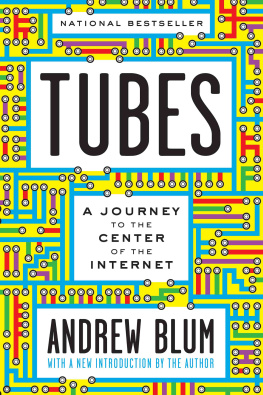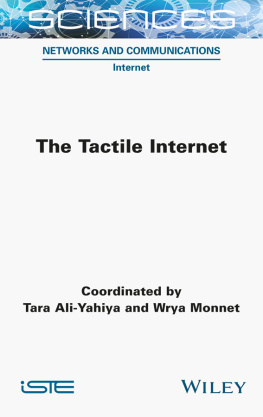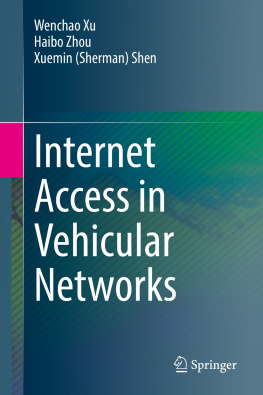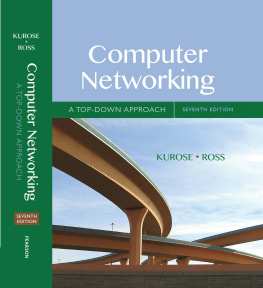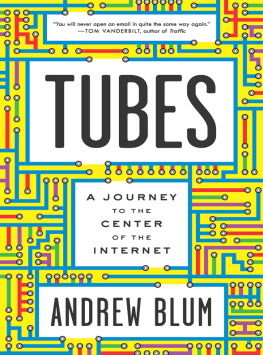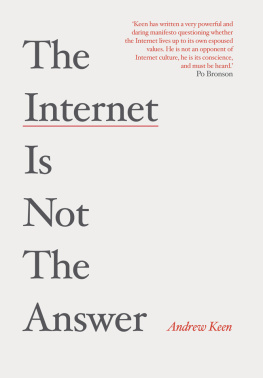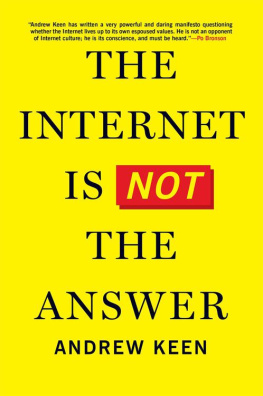In the process of writing this book, I visited dozens of corporate data centers, submarine cable landing stations, and Internet exchange points. I crossed through man traps (double doors that unlock one at a time, for security), peered into cages (fenced-in equipment enclosures), and traced the wires snaking through ladder racks (ceiling-mounted cable shelves). Again and again I toured these places with helpful guides, pointing at boxes with blinking lights and asking, Whats this? Their answers were often thorough and generous. Never in those tours did anyone come up short, slamming closed a half-open door or shunting me past some secret installation.
I wouldnt go so far as to say that this physical infrastructure of the Internet was literally open to everyonemuch of it was locked away inside unmarked buildings behind high fences. But its ethos was open. The Internet is a network of networks; it demands interdependence and cooperation, and a willingness on the part of its operators to worry not only about their own networks, but their interconnections with other networks. Infrastructure, like architecture, reflects the ideals of its creators, and the Internets astonishing emergence in the 1990s and 2000s depended on this collective spirt. It was vivid in my reporting: the network engineers, data center builders, and undersea cable technicians were welcoming and uncensored, genuinely eager for me to understand their piece of the Internet and, once permission was granted, to come inside their discreet and secure facilities, ready to show off every nook and cranny, or, in a few cases, leave me alone to have the run of the place. Their stories are in this book.
But in the years since, that ethos has been threatened. It is easy to pinpoint when I was startled by these changes. Just after 5 p.m. on June 5, 2013, the Washington Post published the first of what became a long series of bombshells based on the documents leaked by National Security Agency contractor Edward Snowden. I was on a train from Washington, DC, clattering across the Maryland suburbs, not far from the NSAs headquarters, when the article dropped. It described a program codenamed PRISM, which gave US and British intelligence agencies access to the user data held by nine major American Internet companiesGoogle, Facebook, Apple, and Microsoft among them. Thanks to both spy movies and past press reports, I had a rudimentary understanding of the broad capabilities of the NSA to intercept phone calls and emails, and a loose faith in the appropriateness of those actions. But I knew immediately that this revelation was of an entirely different magnitudethis story would break through the chatter, with consequences both for our understanding of the Internets infrastructure, and the role of Silicon Valleys giant companies in our lives.
With PRISM, the line between the governments collection of data for espionage and Silicon Valleys collection of data for profit wasnt so much crossed as erased. As journalists Laura Poitras and Barton Gellman wrote, There has never been a Google or Facebook before, and it is unlikely that there are richer troves of valuable intelligence than the ones in Silicon Valley. This collection of data was subject to the approval of a top-secret intelligence court (and was immediately denied by the companies involved) but it nonetheless made it clear that the terms of the debate had permanently shifted, and the conventional wisdom about Silicon Valleys benevolence was about to swing wildly. All this happened long before the 2016 election, before uncountable privacy breaches (both accidental and deliberate), and before an endless series of missteps that continuously exposed an inveterate carelessness with keeping our private information private. Before 2013, I had noticed a tendency to give the giants of Silicon Valley the benefit of the doubtto put what they do for us (whether free email, or web searches, or storing our documents) ahead of what they extract from us. After Snowden, and more so each year, that is no longer the case.
The special knowledge I had from studying the physicality of the Internet made those first Snowden revelations particularly startling. I knew how much these companies knew about us, butmore importantI also knew how little we knew about them. I saw how deliberately Facebook and Google, among others, kept the specifics of their work hidden, making it nearly impossible to understand even the simplest details of how their sites operated. (To take one basic example, why Facebooks News Feed puts some posts ahead of others remains inscrutable.) I had experienced their obfuscations firsthand, heard their nonanswers or, worse, endured their condescending reassurances that they had the whole privacy and security situation under control. The PRISM story was bigger. It suggested that there were whole continents of things I didnt even know I didnt know. Along with the further revelations of tapping and data collection gleaned from the Snowden documents, it began to seem as if there were a shadow Internet, built to siphon the contents of the main Internet. This was hard to imagine. I knew the effort and expense of keeping the first Internet up and running; the existence of a sort of second, secret, Internet was an astonishing revelation. But more to the point, if there was a parallel Internet, how had I missed it? And what else had I missed?
In retrospect there were clues. Most notably, I remember an interview with the CEO of a trans-Atlantic undersea cable, who helpfully answered all my questions. But when I asked about visiting his cable landing station he dismissed the possibility, which was unusual. In summary we dont really welcome it, as part of our security is just being low profile, he said. When the Snowden documents trickled out, I saw that one of the key tapping locations of the GCHQ (the United Kingdoms version of the NSA) was nearby. Had he demurred about a visit because I might point at a box, ask Whats this? and thereby expose a tap that it otherwise required a monumental leak to reveal? That seemed unlikely. But his reticence (which Id hardly registered at the time) only highlighted all that I hadnt seennot merely the so-called dark web, with its hackers and illegal marketplaces, but the full breadth of information being collected by the Internets biggest players, like Google, Amazon, and Facebook.
The physical infrastructure of the Internet I describe in this book is still there. Its structure and organizing principles are mostly the same as when I began my reporting. What has changed is the valence of it all: the stakes are higher, the darkness more exposed. As I reflect on the evolution of the Internets infrastructure over the past decade, both what we know about it and why it matters, what unfortunately becomes clear is that our worst fears about the Internet have come true. The network has crept further and further into our private lives, with webcams and digital assistants, smart watches and thermostats, apps for taxis, apps for pizza, and apps to track our health. In the process, it has become more inscrutable. Each new revelation of tracking, surveillance, stolen passwords, or algorithmic biases only clarifies the need to understand the systems Silicon Valley has created. That is challengingespecially when theres a strong business case for keeping us ignorant. But I know that understanding the Internets physical pieces is a step toward better understanding the more complex virtual ones: the algorithms and code upon which so much of our lives depend.

